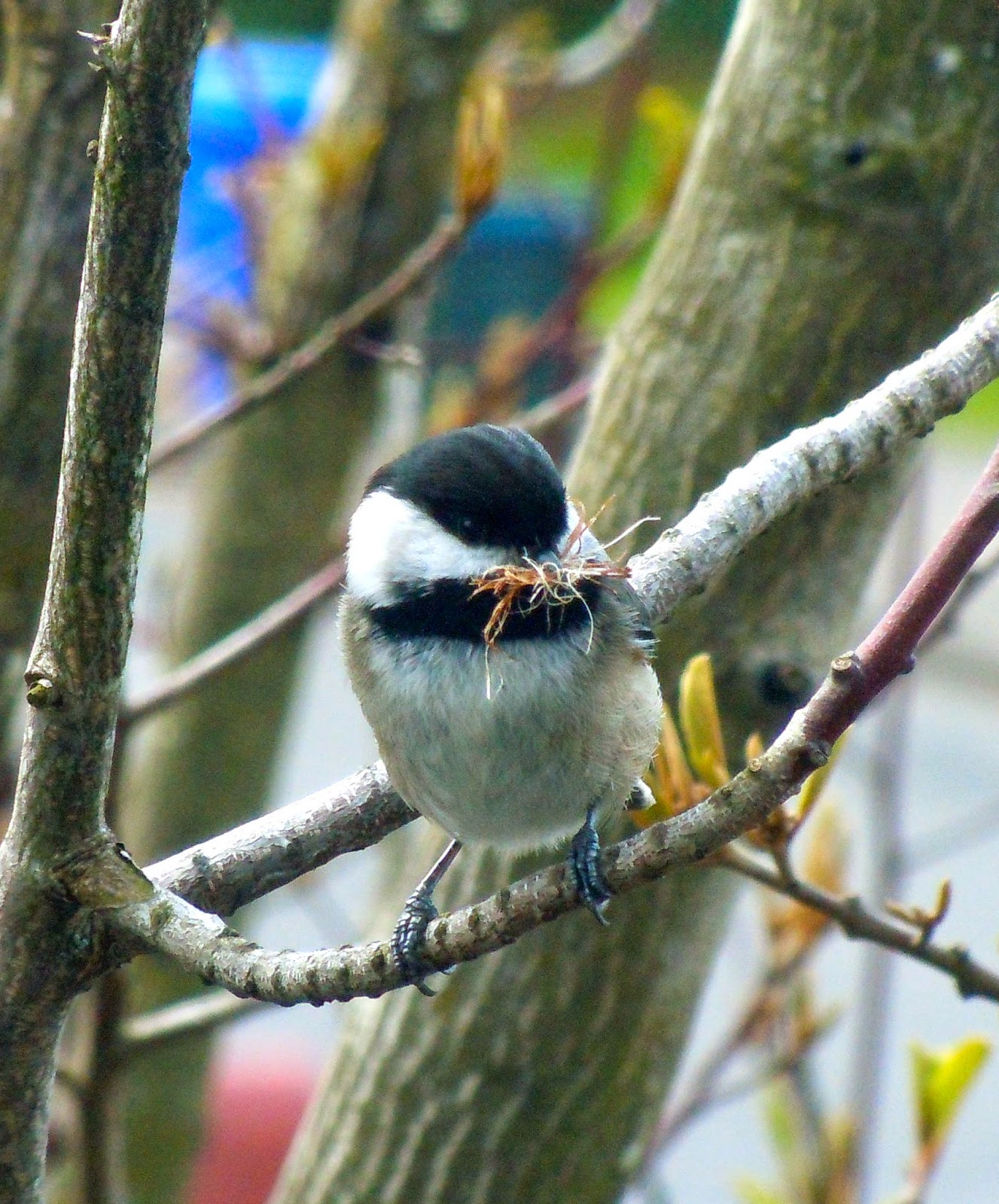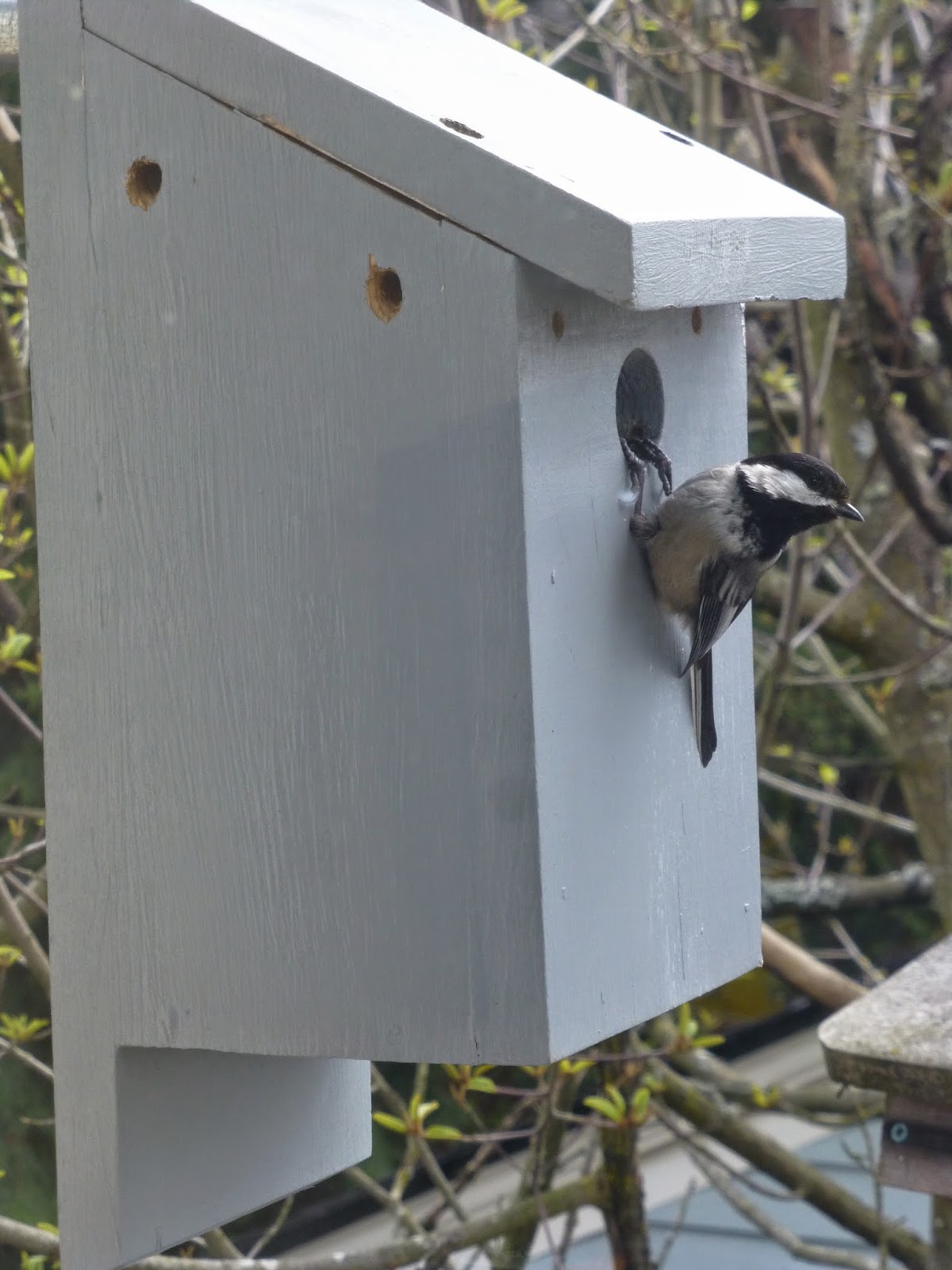It’s spring, and as usual, I am obsessing about the new-chickadee production line. Every year I am privileged to witness a pair of chickadees setting up house in a nesting box mounted a foot outside my writing window. (That might seem close, but it’s not hard to live right next door to a writer. They’re real quiet and most of the time they don’t even move much.) Anyway, with the chickadees, there is nothing to distinguish one bird from the other until an egg drops out of one of them, and that probably takes them by surprise, too.
It is said that one way to determine the sex of a chickadee during nesting season is to notice its behavior. If it is fluffing and flapping like a baby bird and demanding to be fed, it’s probably a female. If it falls for it, it’s probably a male.
There are other ways of telling a male chickadee from a female, if he’s got spring fever, but no polite ways. Both birds have a cloaca, or a hole they pee and poop through, and unless an egg happens to be shooting out of one of them at the time, they look pretty much the same. Supposedly the cloaca on the aroused male chickadee is a little swollen, although, as always, that’s the kind of claim that can be prone to exaggeration.
Anyway, you’d have to grab the bird and flip it upside down and blow on its belly feathers to tell, and I wasn’t raised that way. We were Lutherans. Every one of us was conceived in chastity and dedicated to the proposition that all men procreated politely and with only as much fuss as is necessary, and no more. We’re not really even supposed to think about the cloacal region.
So, as usual, I don’t know the specifics about my chickadee pair. They could be two boys for all I know. Not that I’m judging. That’s as good an arrangement as any, and they can always adopt. Although they’d have to settle for a cowbird.
Assuming it’s new baby chickadees we’re after, though, basically what needs to happen is an encounter between boy and girl cloacas sufficient to transfer genetic material. Nothing is being inserted into anything. And since the cloaca is being used to poop through, it must be admitted that in their case it is pretty much possible to get knocked up by sitting on a toilet seat. The encounter is called a “cloacal kiss.” It can’t be easy. They’re kind of round down there. They don’t bend much.
Nevertheless, I suspect they have been successful in previous years. I can’t prove it. All I can tell for certain is that the birds took an empty box and put peeping sounds in it. Weeks later, there was more than the usual number of identical chickadees hanging around the tree. I could draw quick conclusions from these two observations, but the science-ist in me must acknowledge that there could be alternative explanations. For instance, with the peeping, it could be that my tinnitus might have become temporarily adorable. And, there could have been a chickadee convention booked in my tree. So I don’t
know if my birds made new birds, but I would consider it supporting evidence if I were to witness an actual cloacal kiss.
And then, this year, I did! I was alerted to the activity by an audible onslaught of chickadee sweet-nothings. It’s not real clear to an onlooker when the deed has been accomplished. It didn’t take long. Did they make contact? Hard to say. There was a flurry of feathers, but if an eight-ball and an eleven-ball rolled around together, only time will tell if the numbers ever matched up.
Let it be said that even during the moment of passion both birds fluffed and flapped and begged and twittered like babies in an identical fashion. They still don’t know who’s who. But I don’t think they need to.



What a funny and accurate portrayal of chickadee love. My birds are all busy trying to nest in different boxes this year and I do not know where anybody is!
I wonder: will they nest in clear Plexiglass?
Ah, what a wonderful way to finish up April, with a passionate post from Murr! Loved it and all I can say is, you made my day. 🙂
Make you want to roll around a little?
Mercy! Just give me a moment while I fan myself.
Aviary soft porn. I'm going to watch our bird visitors with a more prurient eye.
Lawsy. I know, right?
I'm pretty sure we've got Lutheran chickadees in our area because, while I've never seen it, I've heard a whole lot of fluffing, flapping, begging, and twittering going on in the privacy of the arbor vitae. In fact, all of the birds that make our yard home tend to use our arbor vitae hedgerows for mating, nesting, birthing, and flight training. This symmetry makes my heart smile.
You've got them all lined up. It's almost military.
You are one funny lady, love your style. My favorite part was between "It's spring" and "need to." I might have enjoyed biology if you were the teacher.
It's possible you wouldn't have passed a standardized test, however.
In Indiana, the rituals were always done in our yard, because of our 6 foot privacy fences – with or without our vacancy sign flashing. If we had charged per second, we'd be living a lot better than we do now.
You'd have been proprietors of a No Tell Motel. I'm not sure that's better living. Enjoy!
We don't have sweet nothings here. Well, not that you could hear, anyway. What we have is big, burly birds threatening to peck out the eyes of our three indoor cats if they should ever exit the screen door where they line up to watch "outdoor TV". It's a wonder there are ever any baby crows, starlings, or bluejays born 'round these parts.
I do love this post. I'm still smiling.
Them is some burly suckers, I'll grant you that.
And thus I now know more about the mating habits of chickadees than I ever thought I would know. 😉
I know a little less than I think I know.
Woo Hoo. Happy and envious dances. And admiration for the agility of your mind.
This comment has been removed by the author.
If not my cloacal region.
My ducks could perhaps learn a little delicacy from the chickadees. As could the red-tailed hawks on the telephone pole this afternoon. And if you've ever seen a rooster "miss" his target, you'll never look at eggs the same way again.
Details please. As for the ducks, UH HUH! I believe we have talked about the amazing exploding duck dick in this space before.
"…my tinnitus might have become temporarily adorable." Ha! Love it!
Most of the time it's like a distant klaxon.
With three feeding areas on the go, I have a front row seat to a lot of billing and cooing here too, Murr. I love when the male cardinal presents the female with a peanut, and she ever so coyly accepts it. The bluejays are more like Italian guys with their yelling, strutting, and combing their top thingummy. The finches are singing their hearts out and yes, the chickadees are all fluffed up and excited. It's great!
I haven't observed the jay thingummy combing. I want to.
Well, "combing" is a bit of a stretch: making it go up and down quite actively, and fully up when another male struts around the feeder.
As long as the chickadees know which is which, then it's none of my Lutheran-raised business either. I'll just stand here and look at my shoes while they do their cloacal kissing.
My brother!
Birds. Okay, now I am eXpecting bees.
I'm not up on my bees. One big fat queen and a slew of minions, that's all I know.
Through the same hole they poop through? They could be illegal in thirteen states.
the Ol'Bizzard
Not the one I'm in now.
I have never thought about bird sex before reading this and hope to not think about it again as soon as I forget. I prefer to think they're just playing 'chasey".
Mommy and daddy are just wrestlin', sugar lamb.